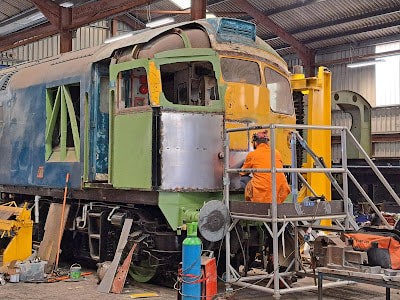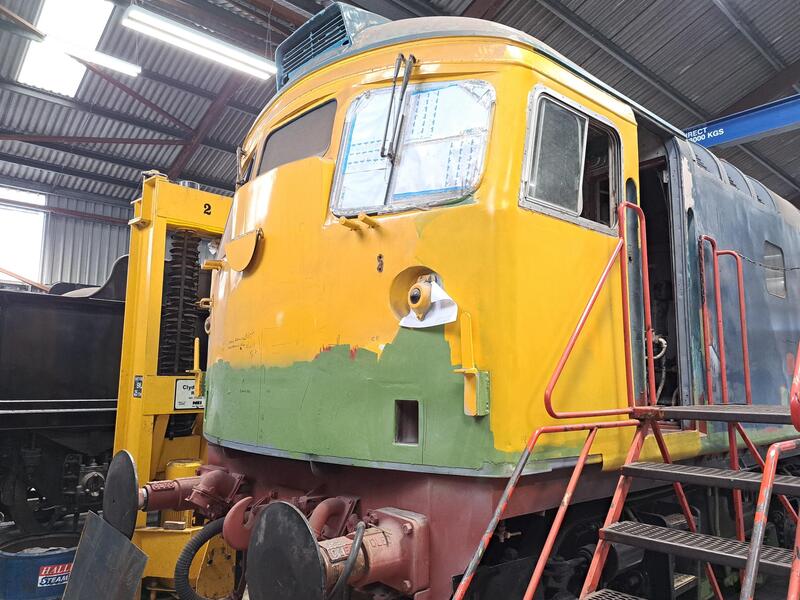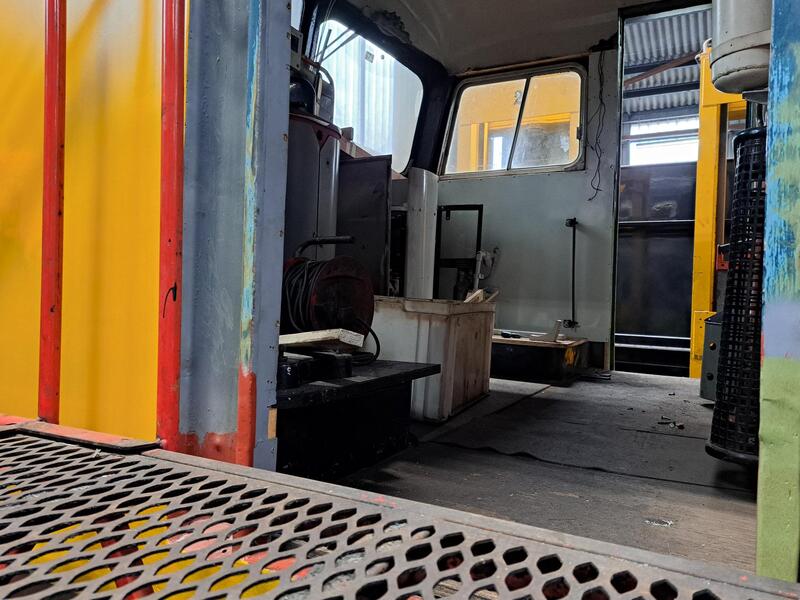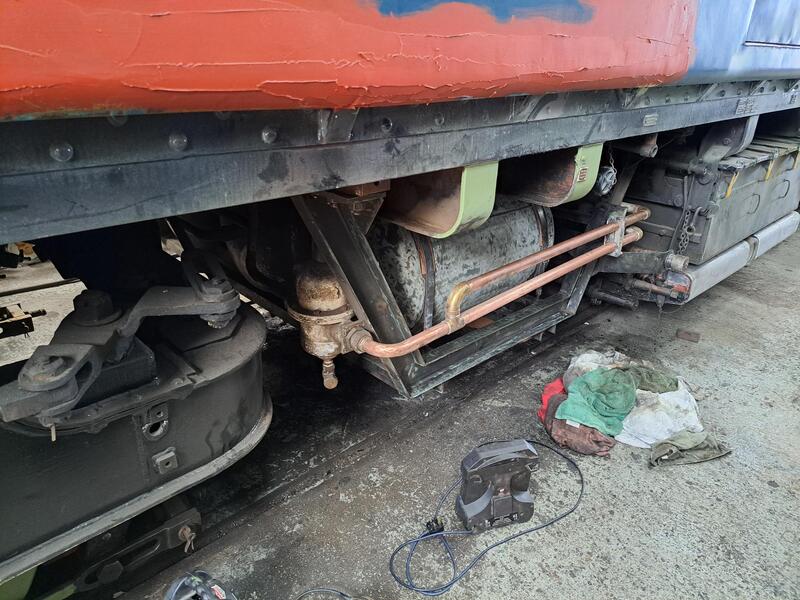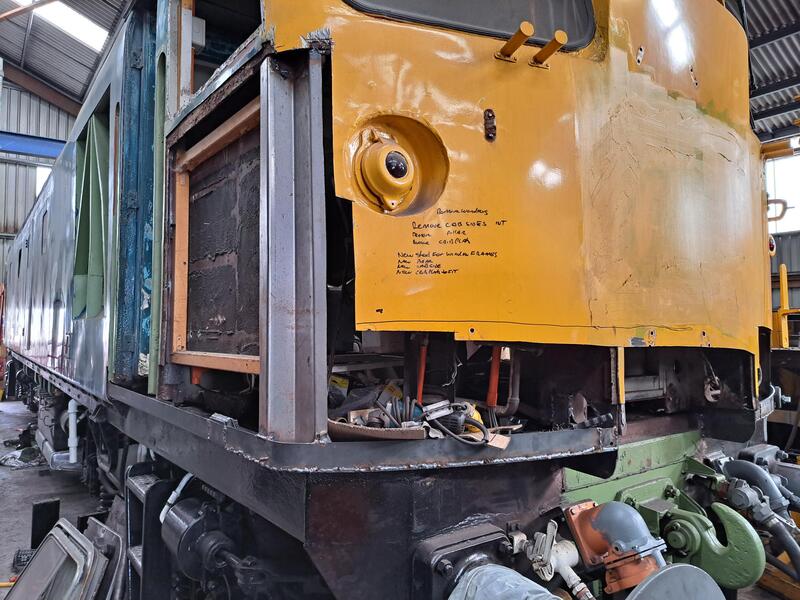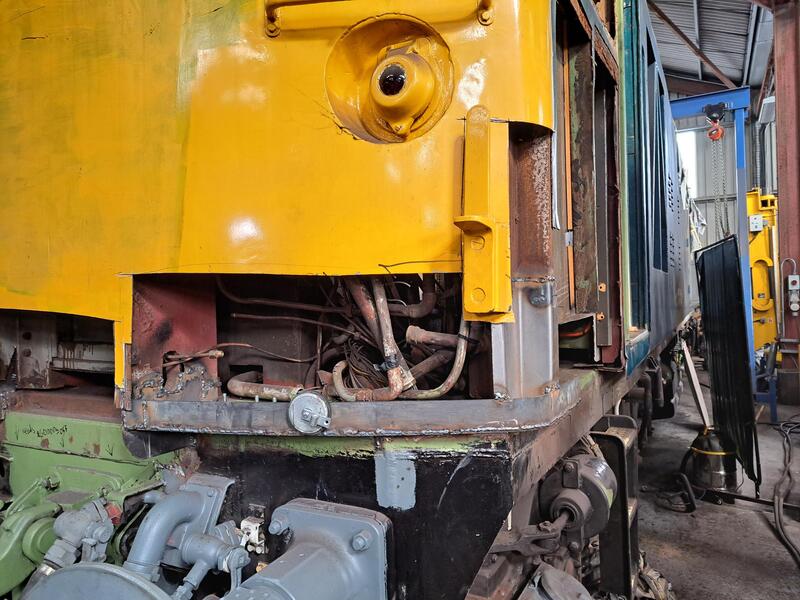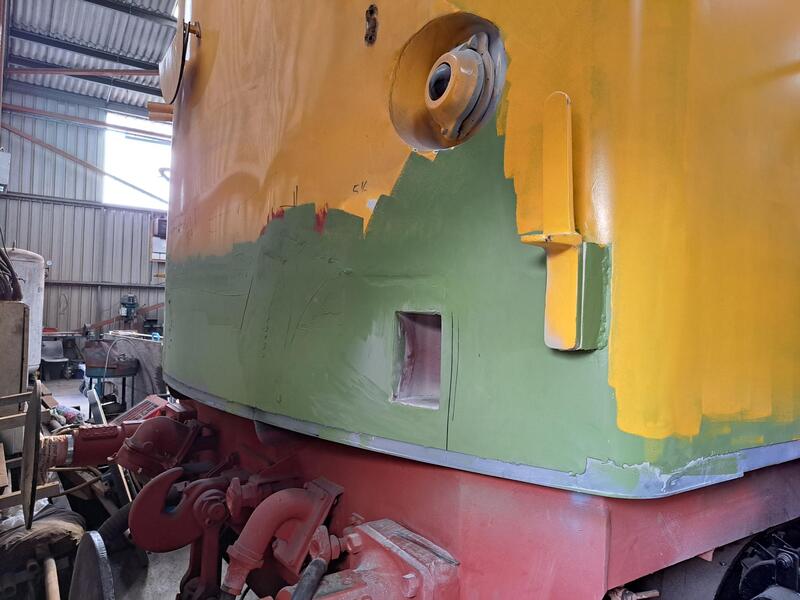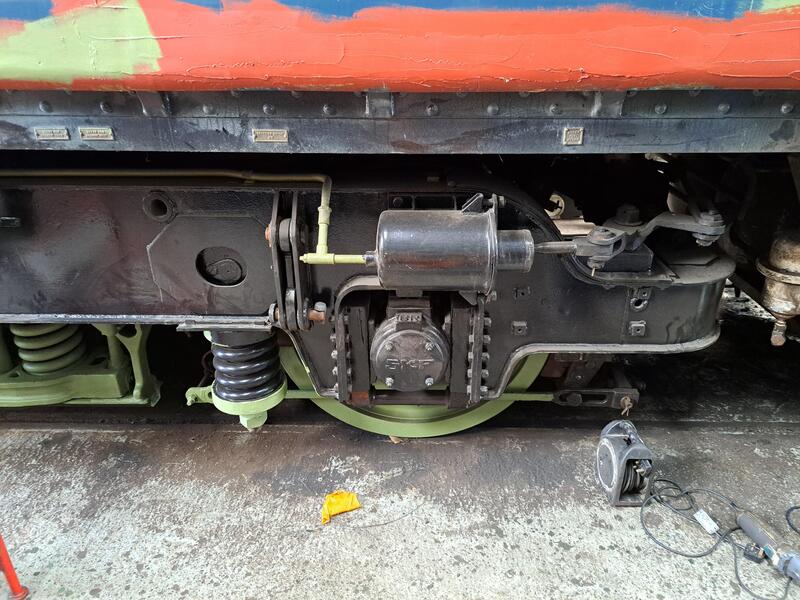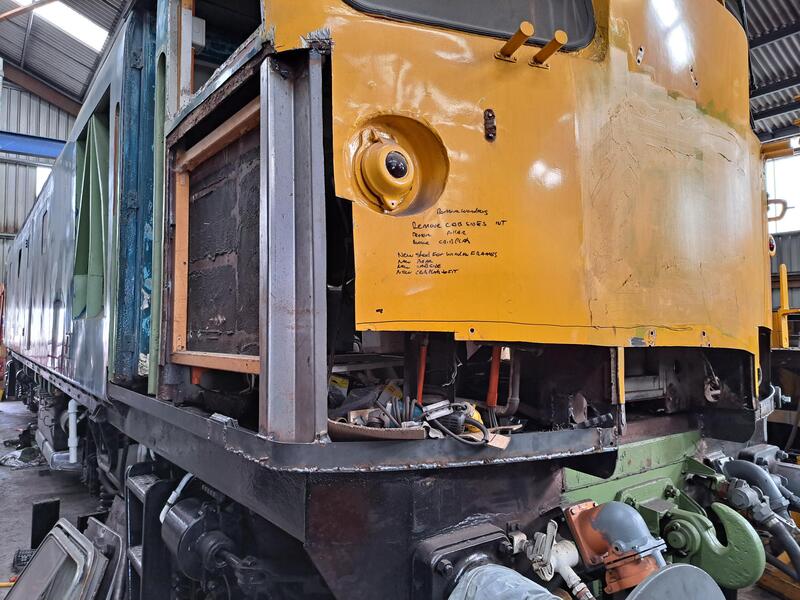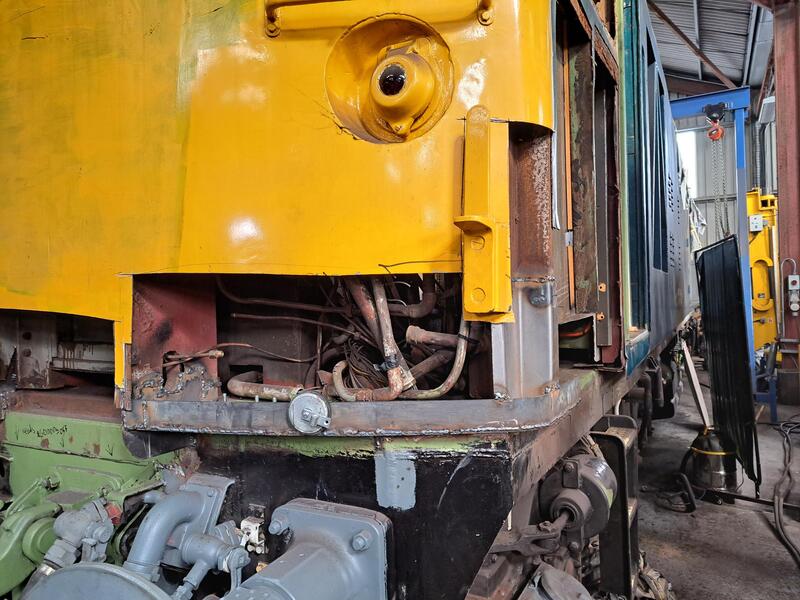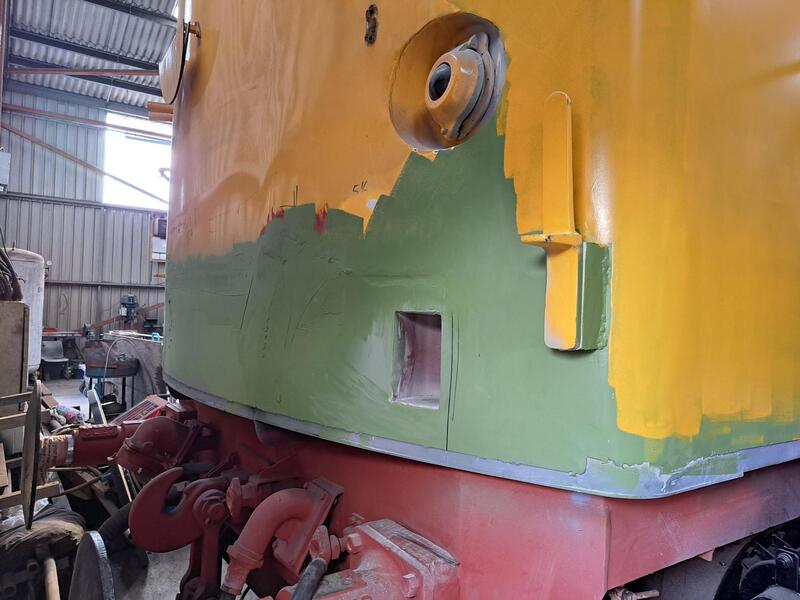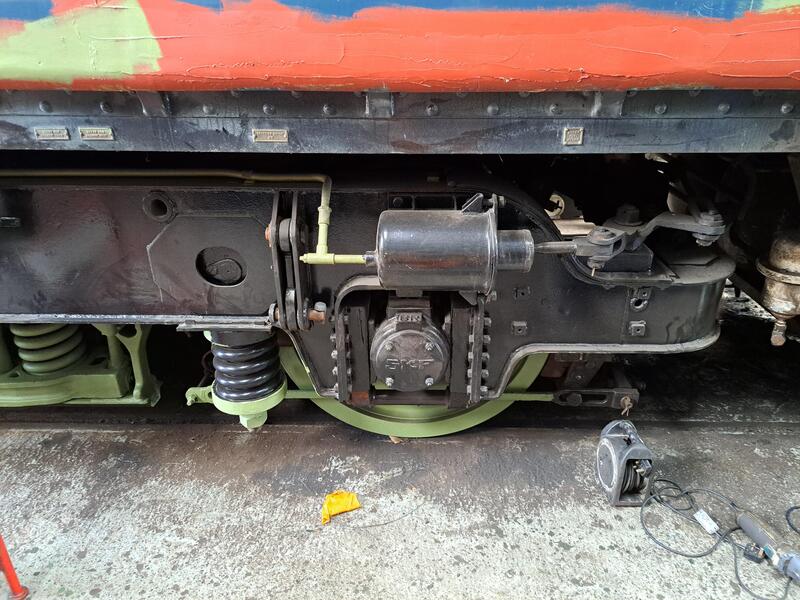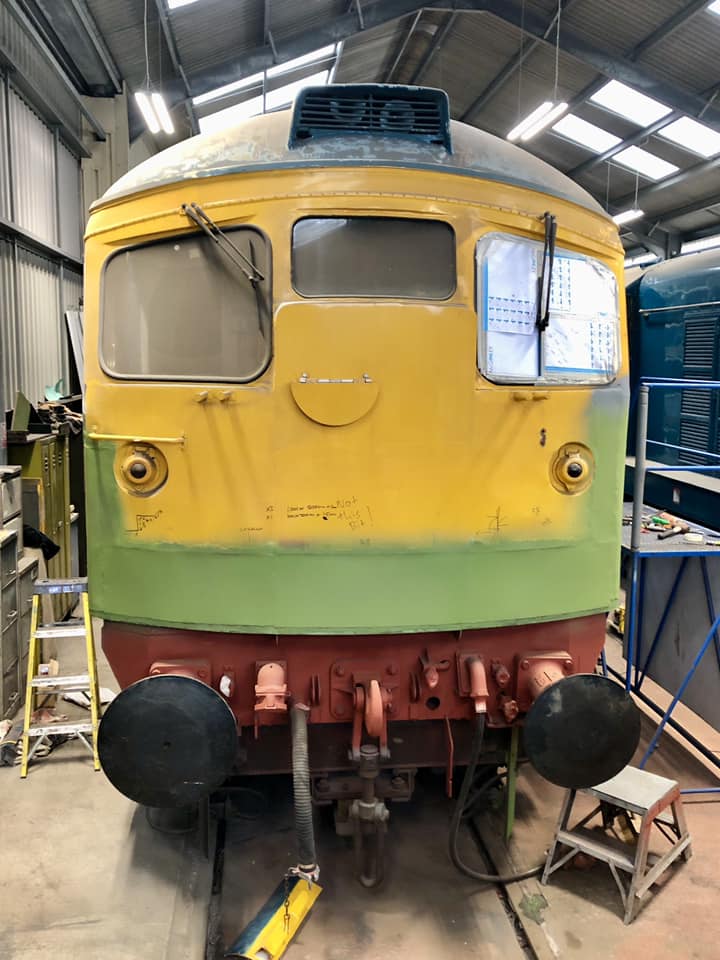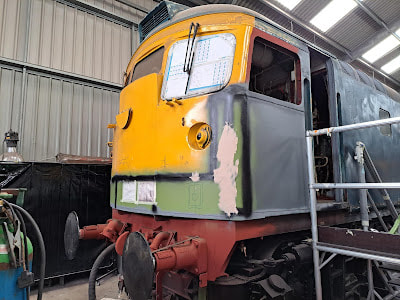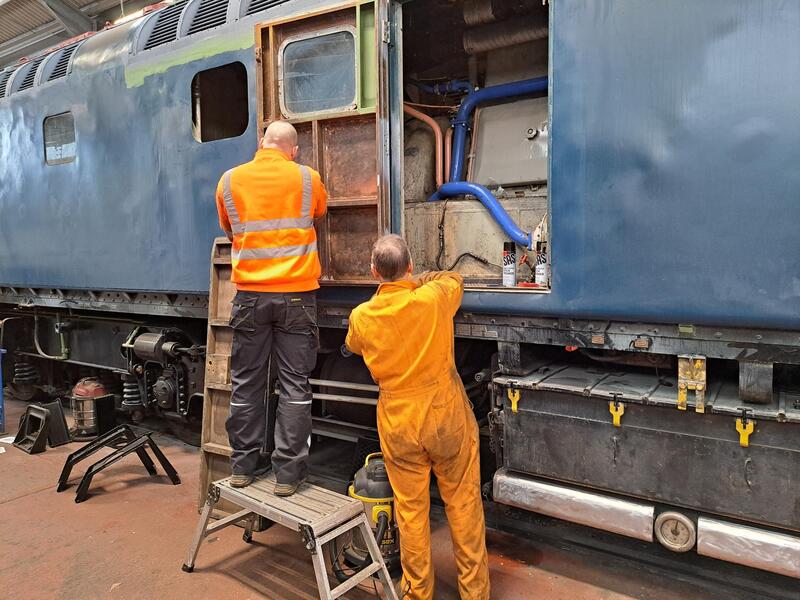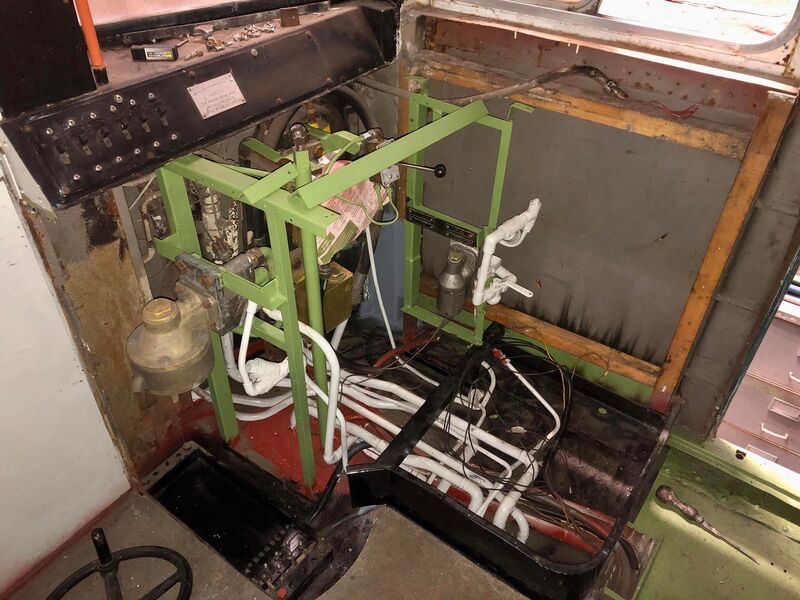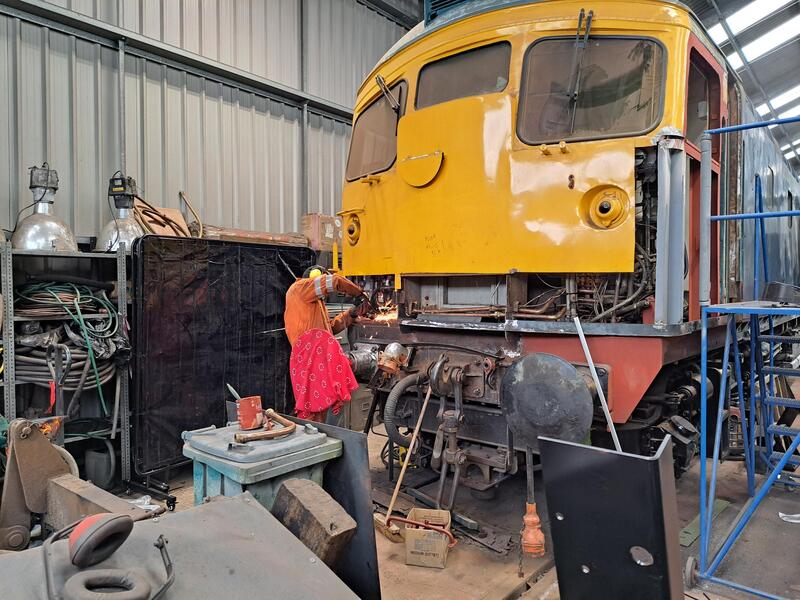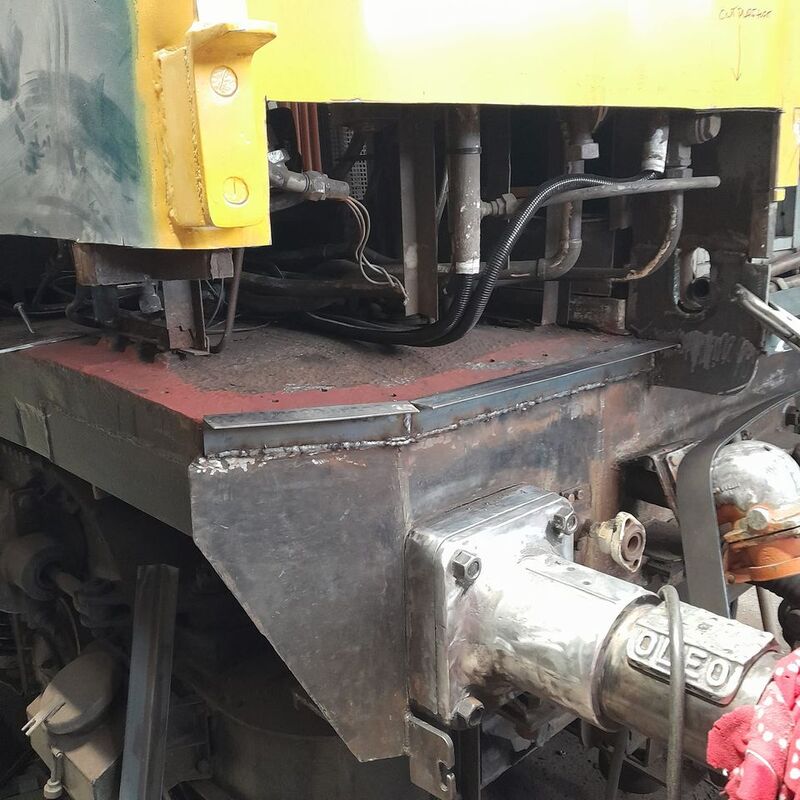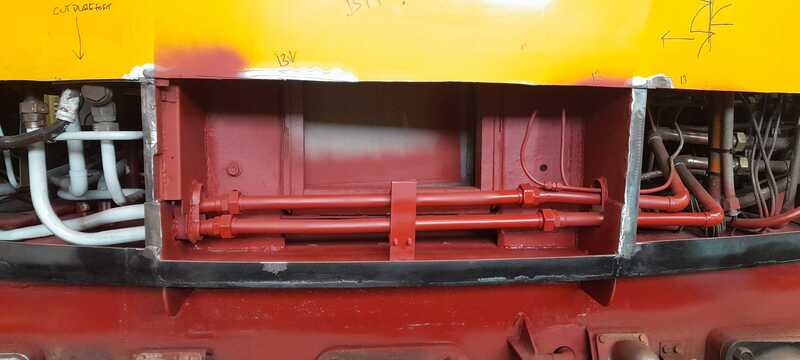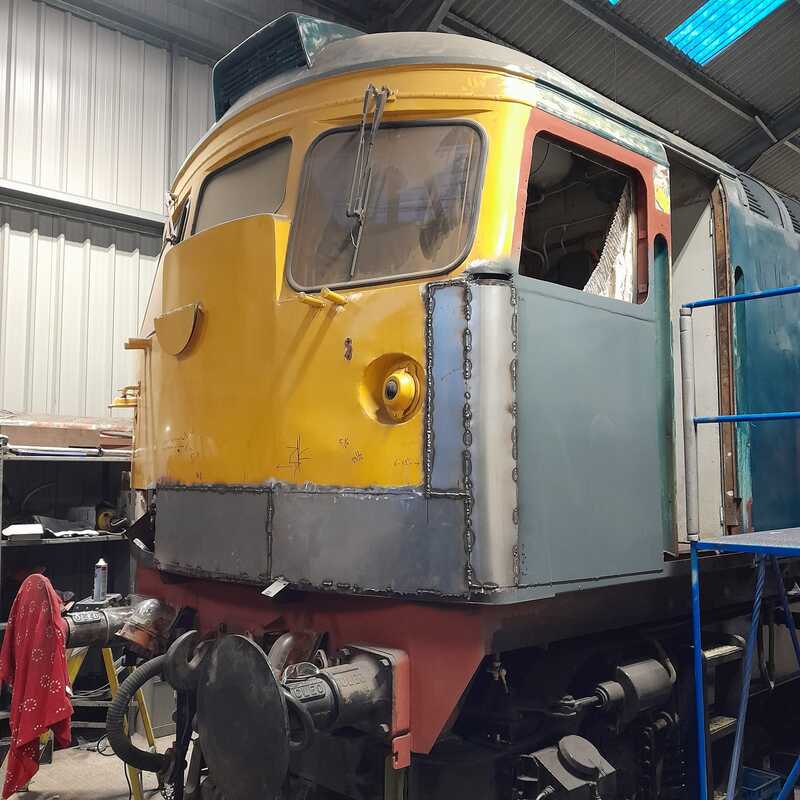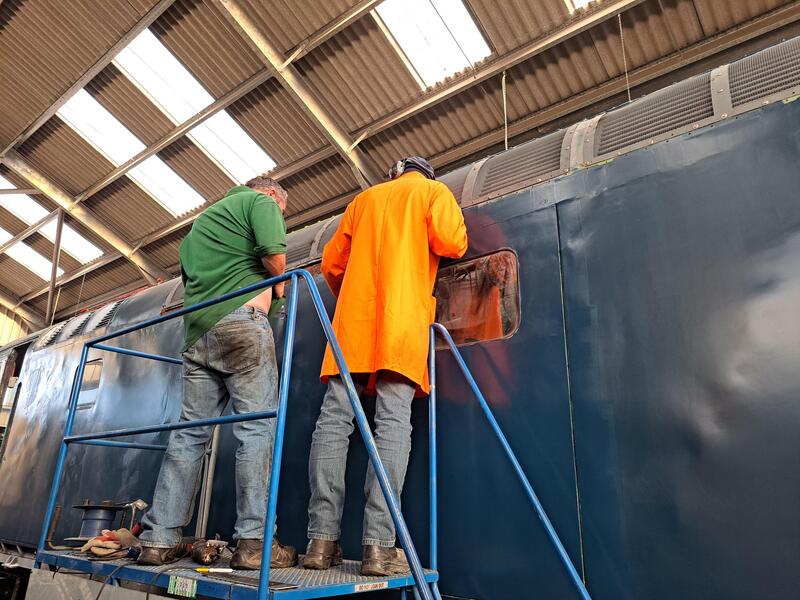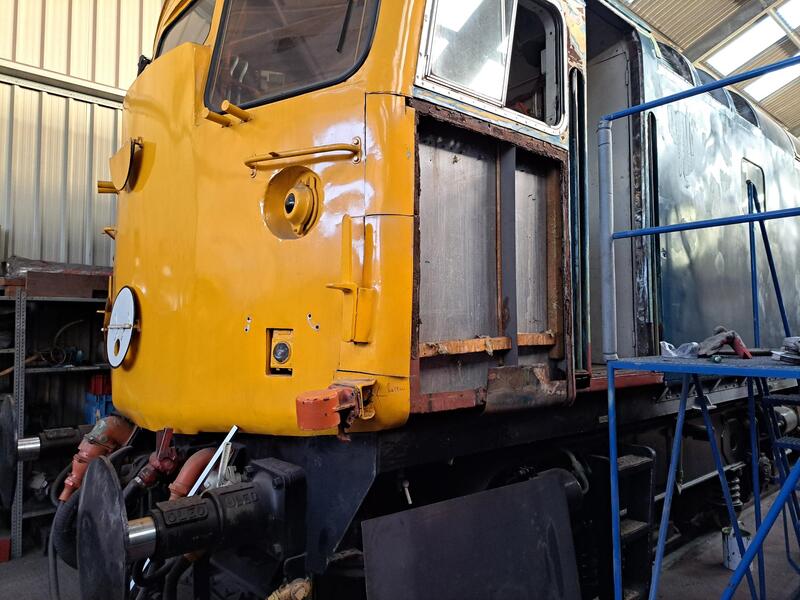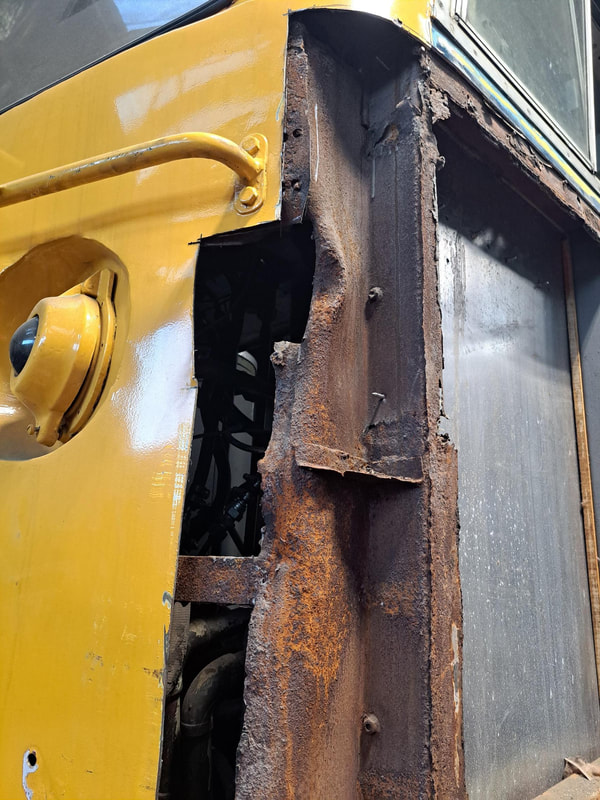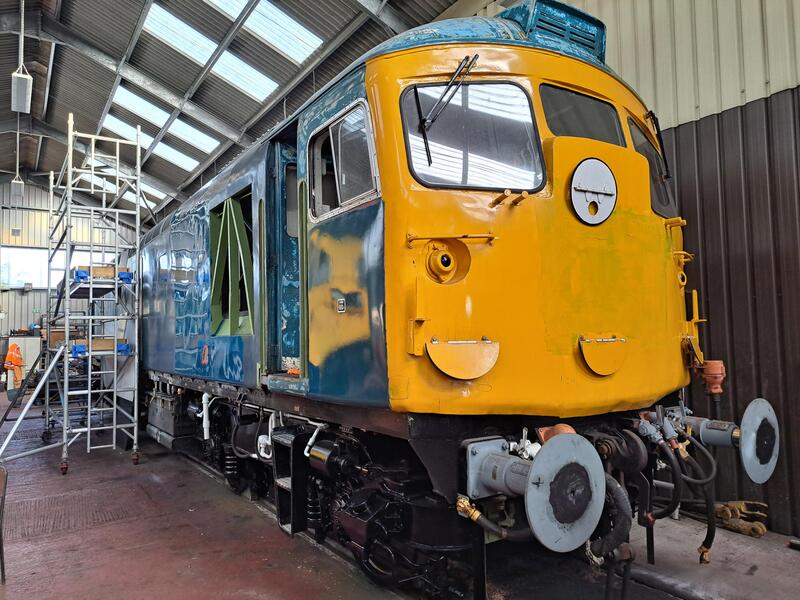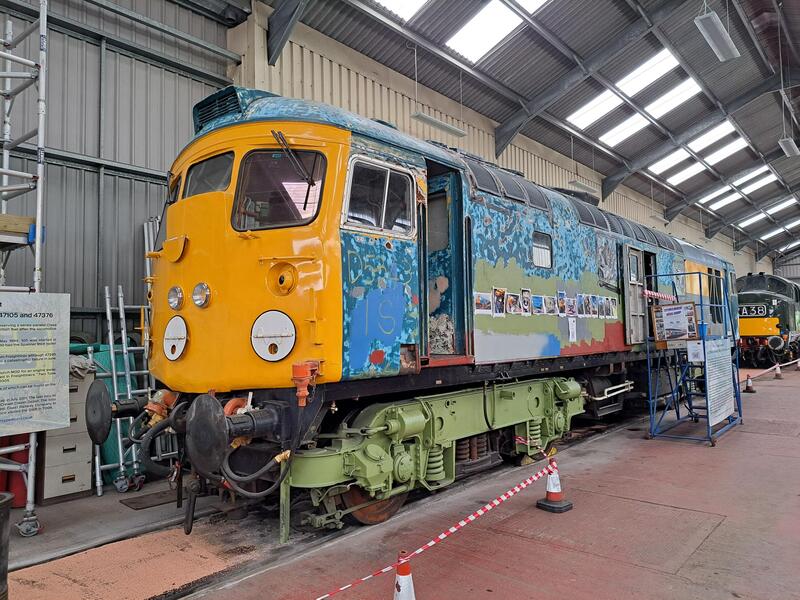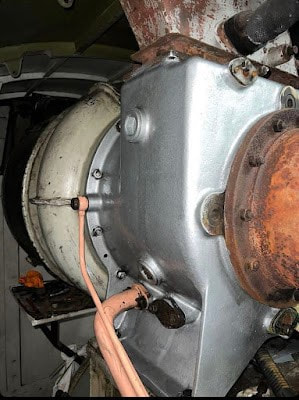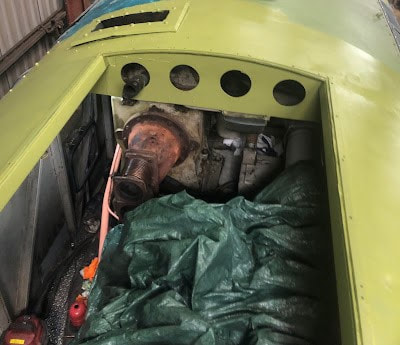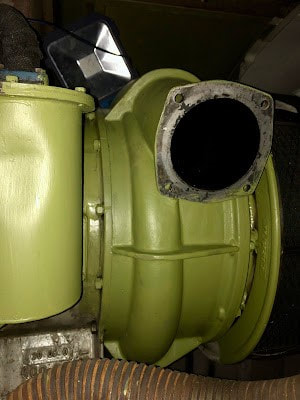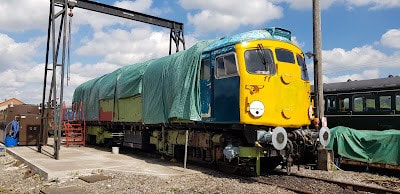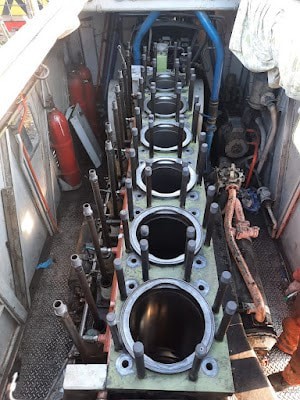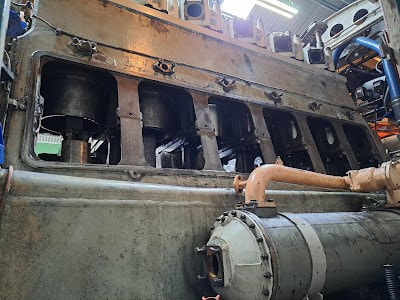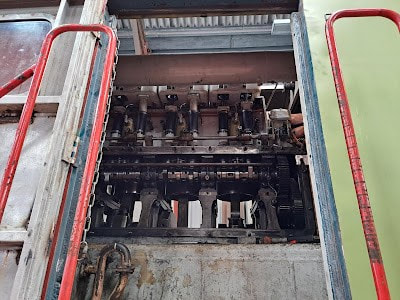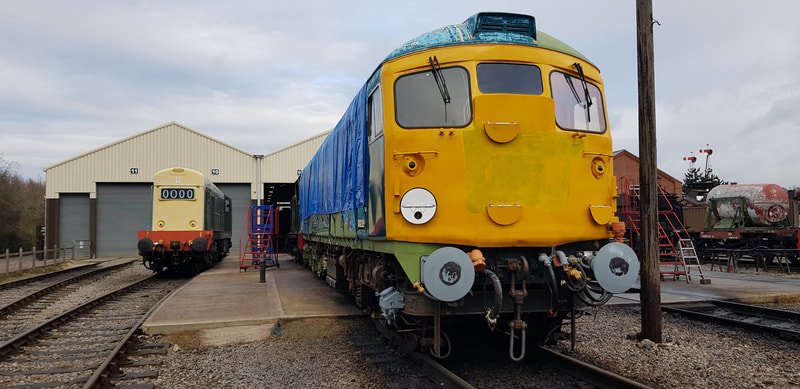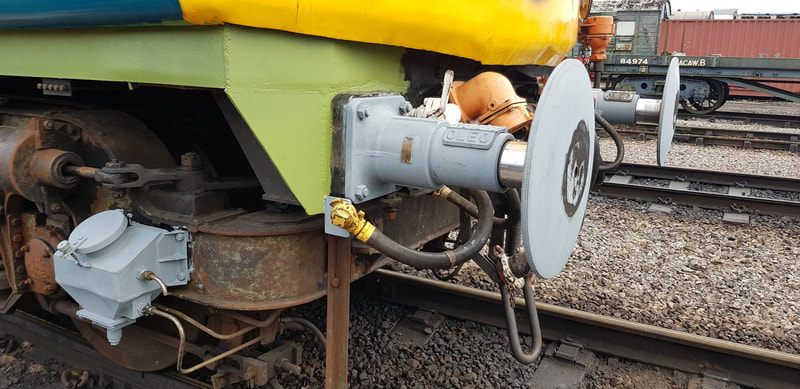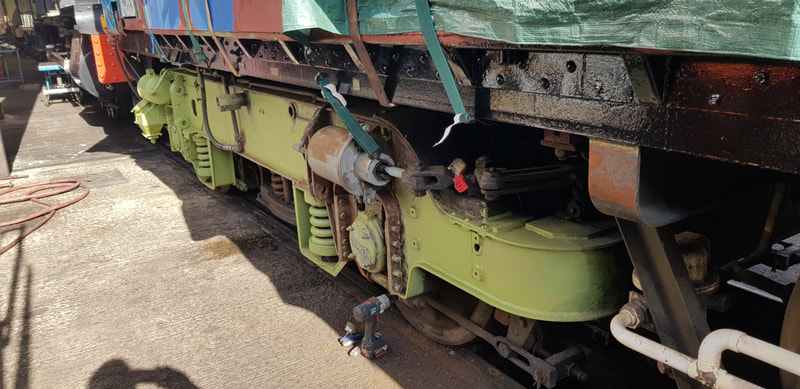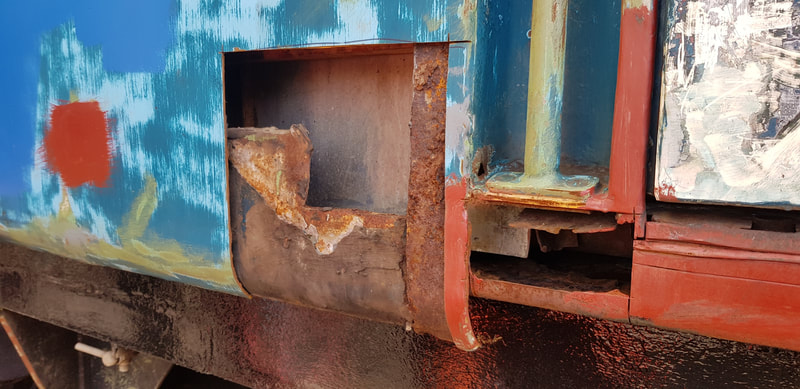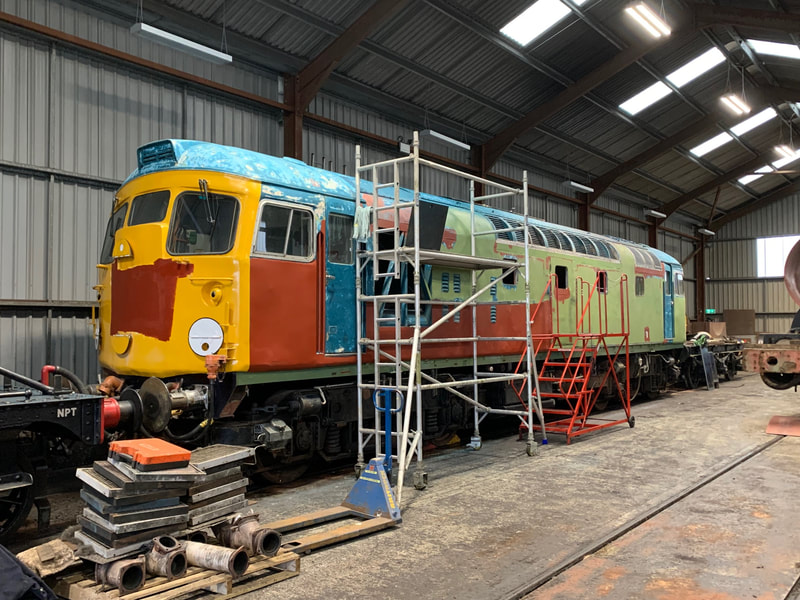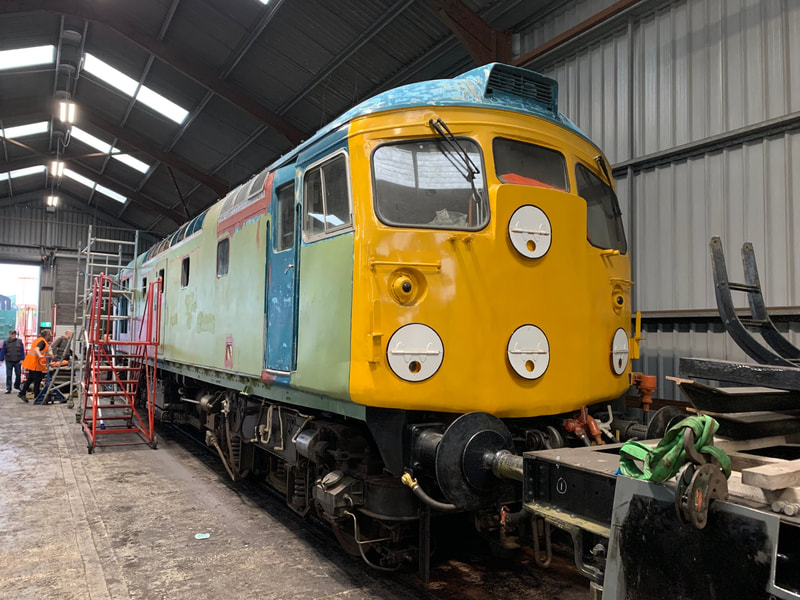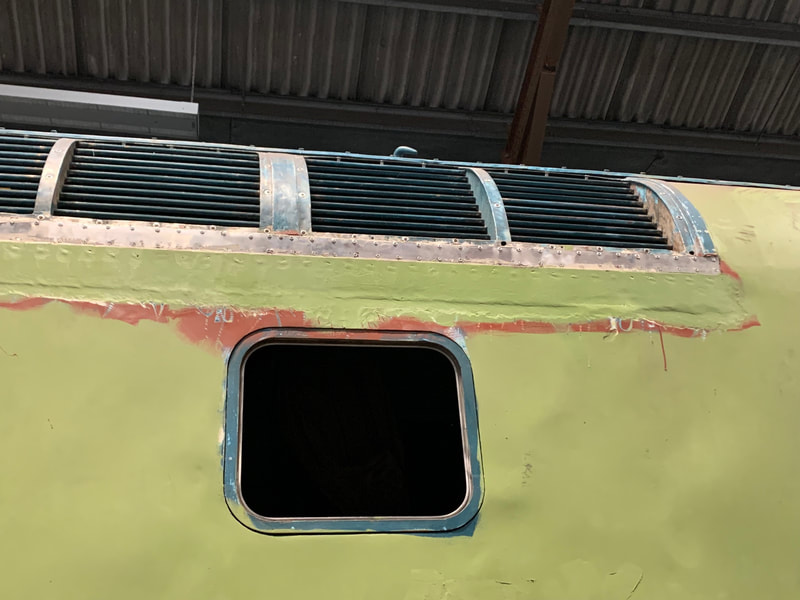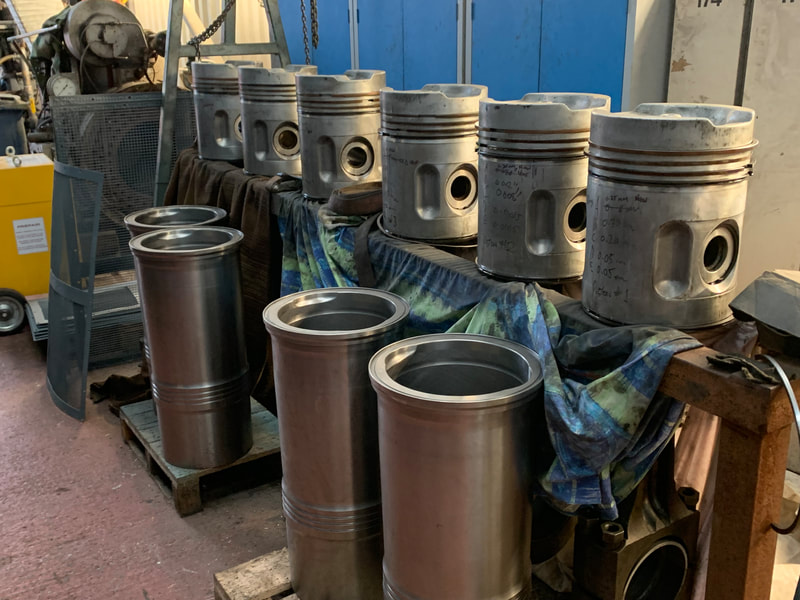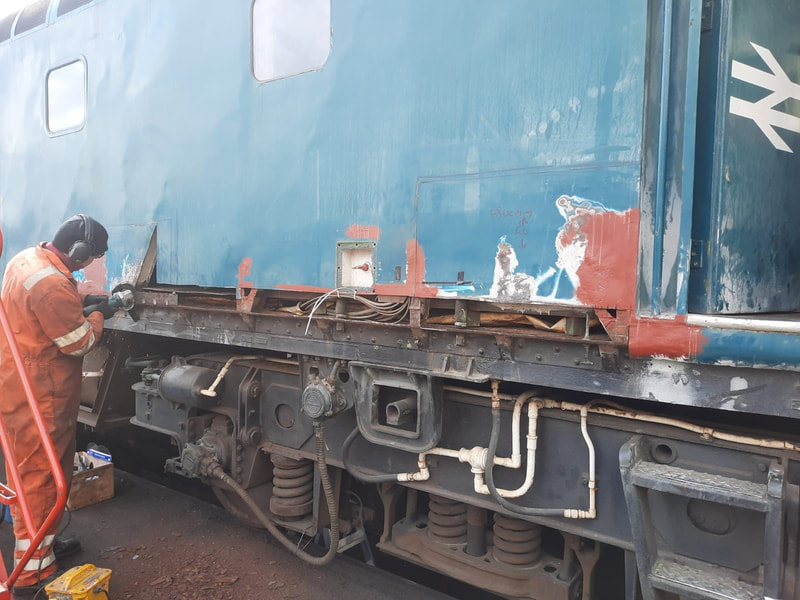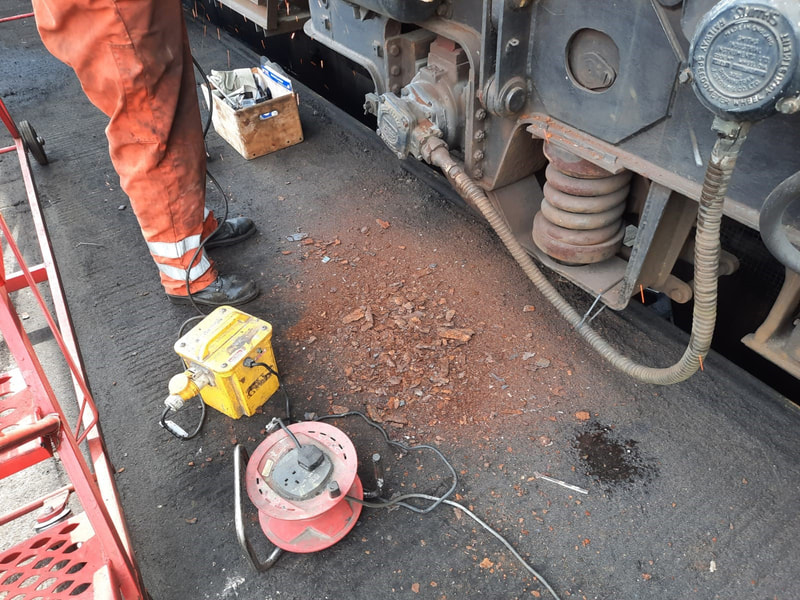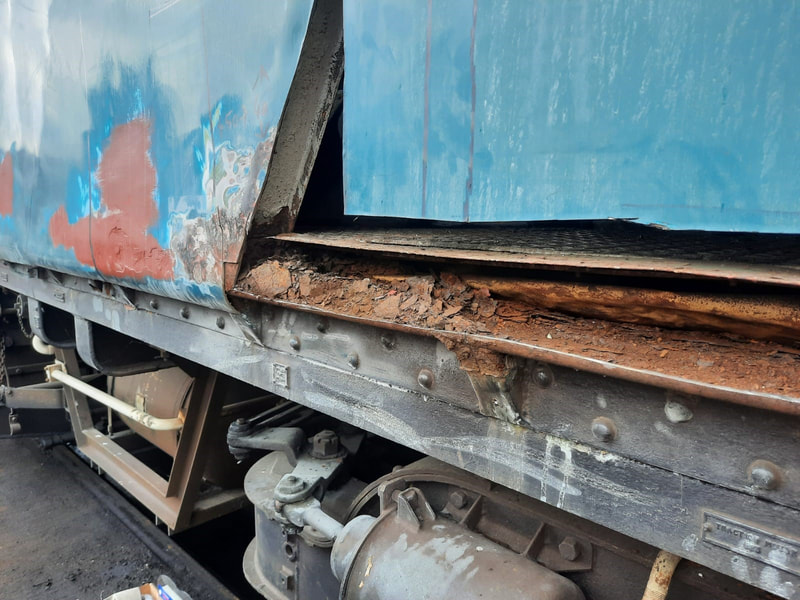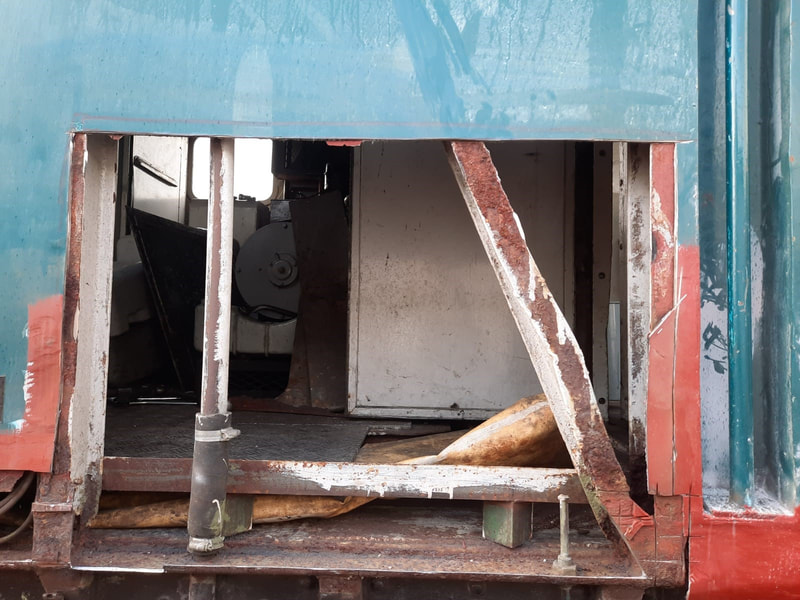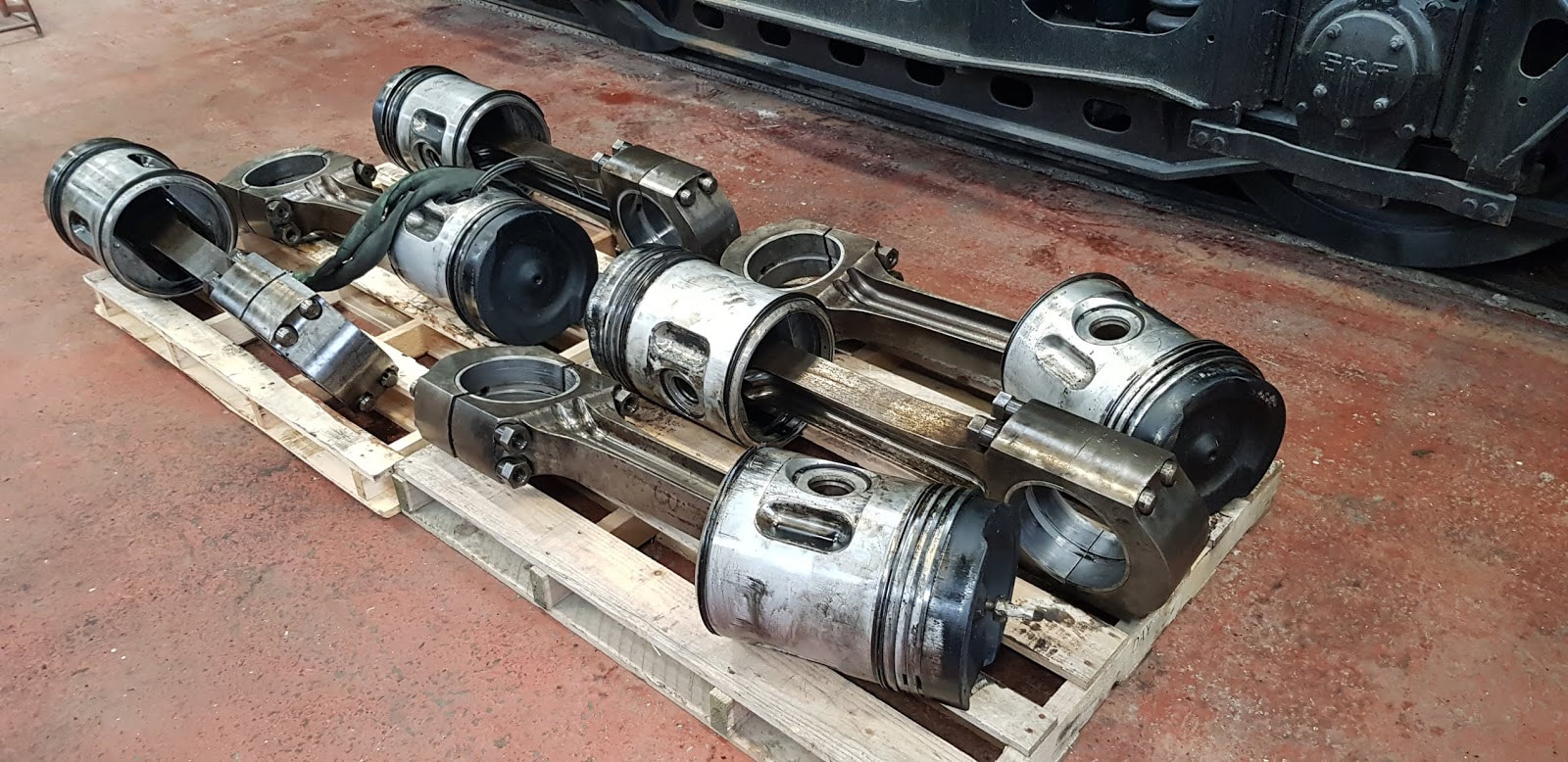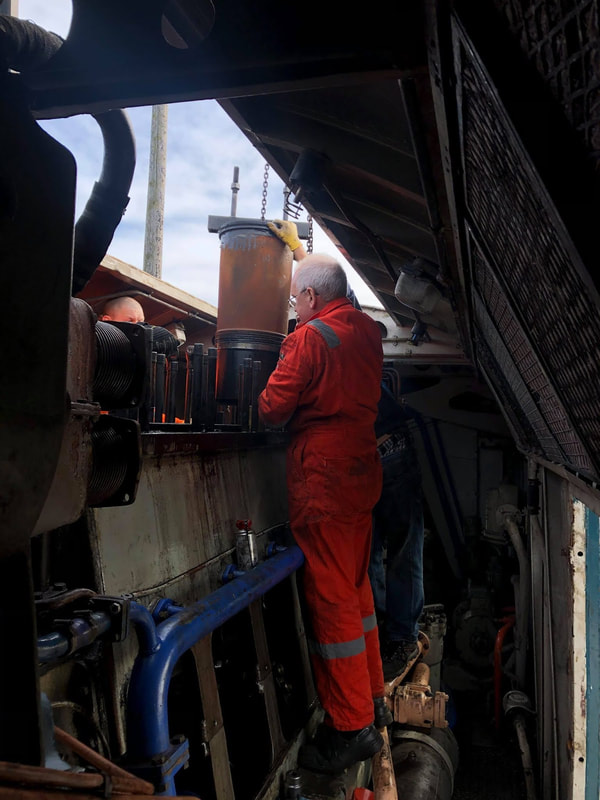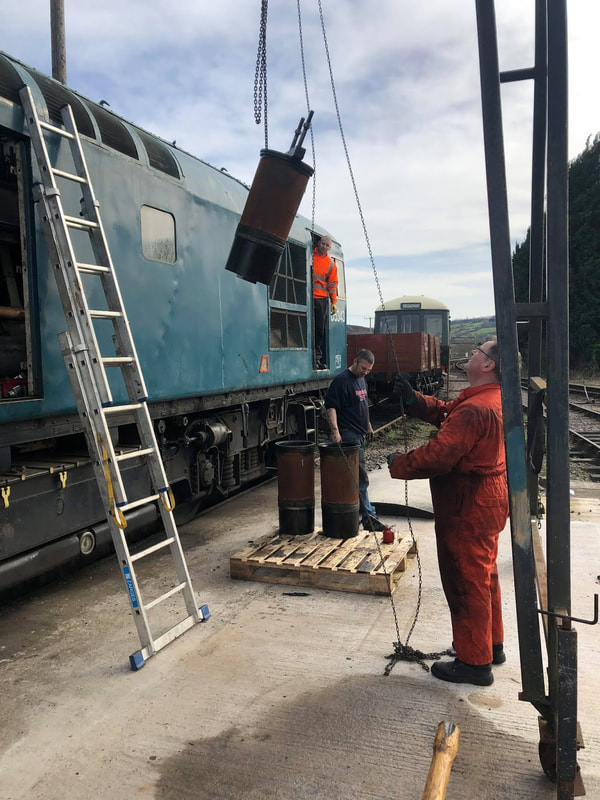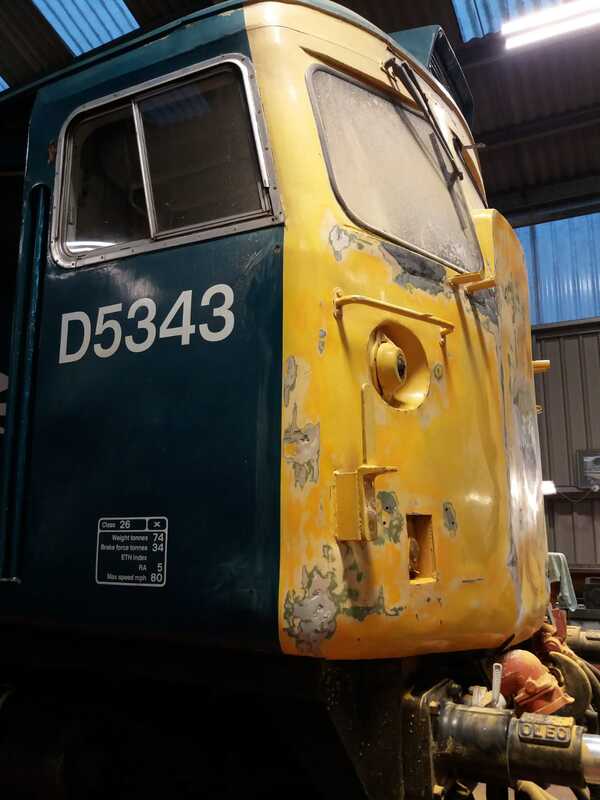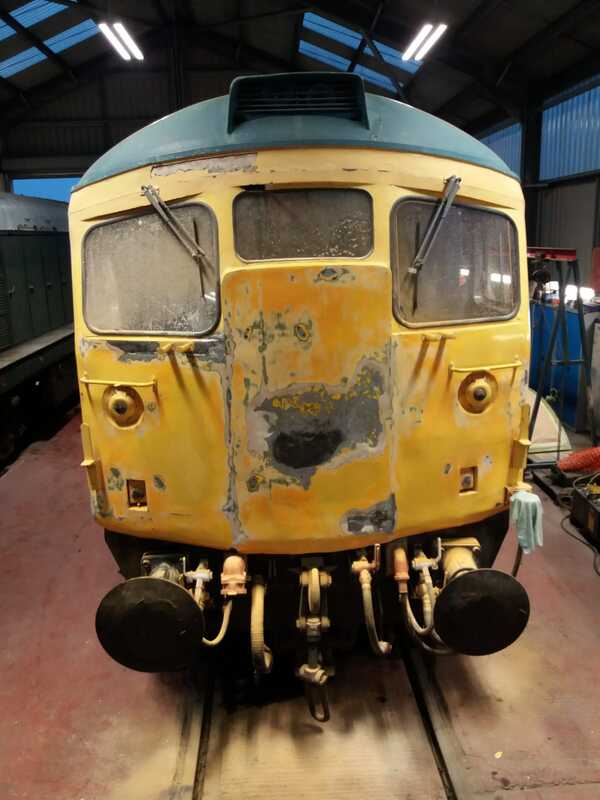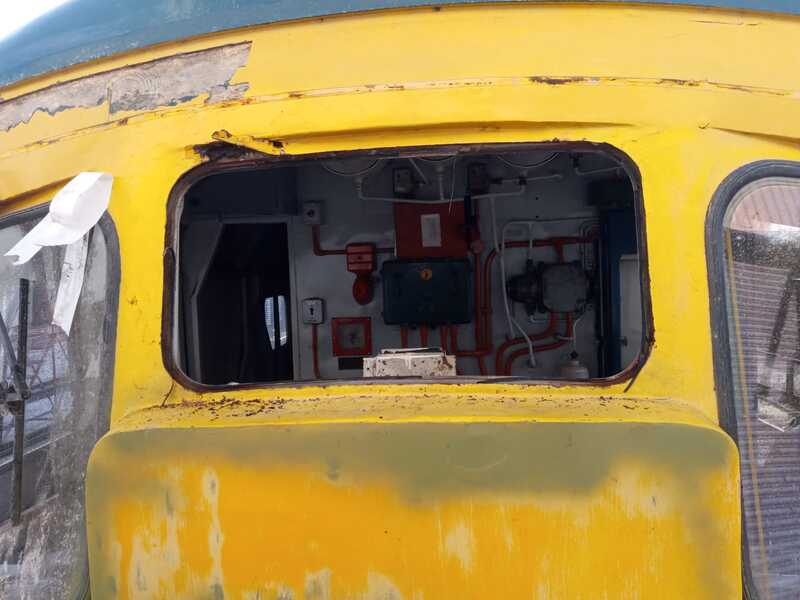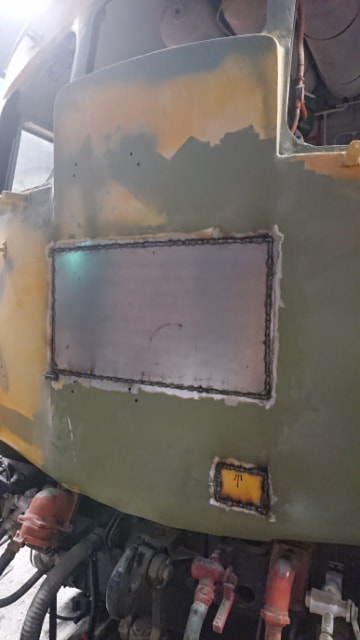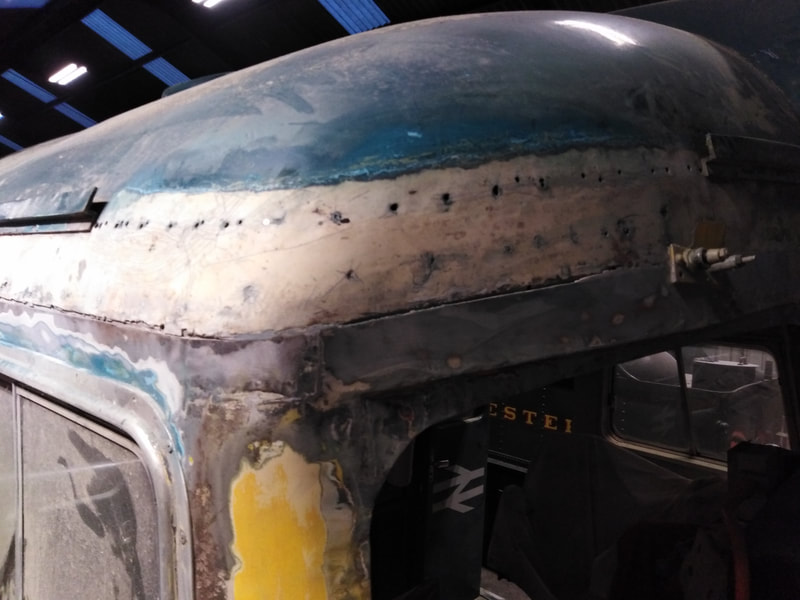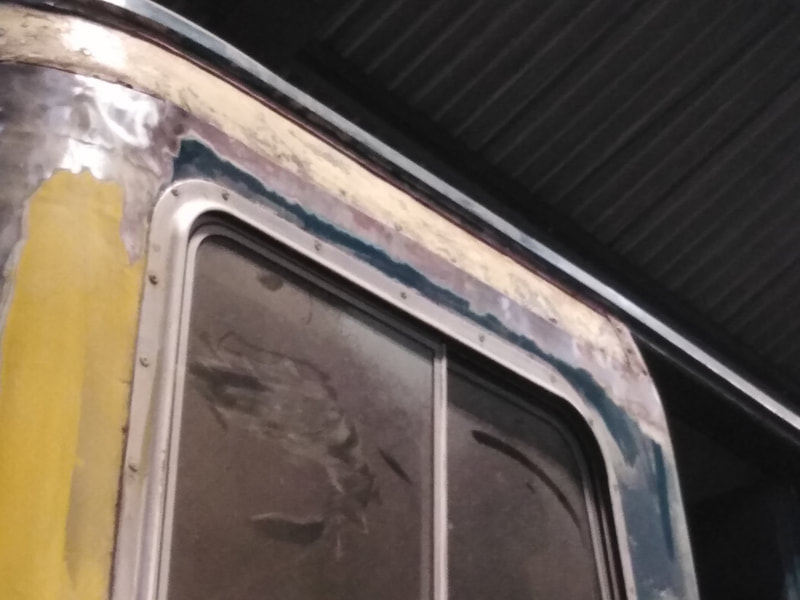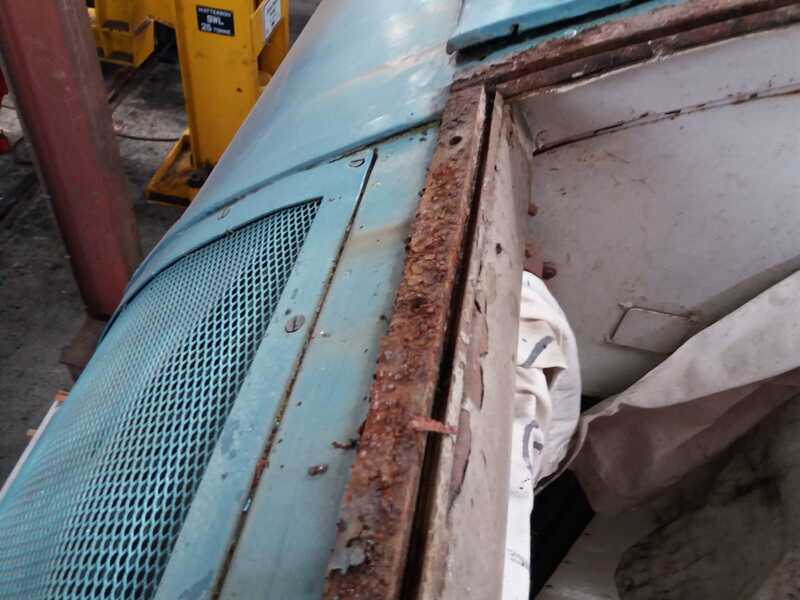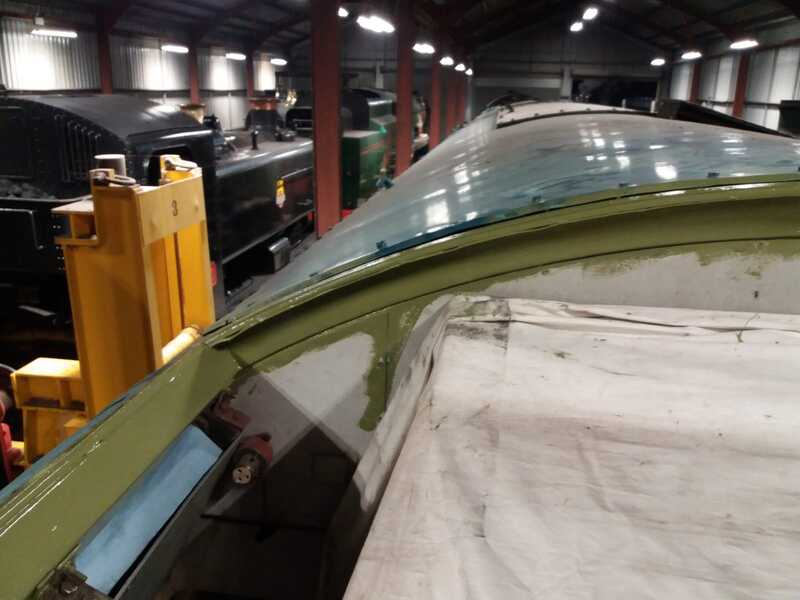The latest information on D5343

Update on repairs to D5343 (July 2024)
Repairs are progressing well, with attention turned to the areas around the cab windows, whilst work on the cab interiors is also ongoing.
The loco was on display in the diesel shed during the GWR diesel gala on 12th-14th July, seen pictured here.
Update on repairs to D5343 (July 2024)
Repairs are progressing well, with attention turned to the areas around the cab windows, whilst work on the cab interiors is also ongoing.
The loco was on display in the diesel shed during the GWR diesel gala on 12th-14th July, seen pictured here.

Update on repairs to D5343 (April 2024)
D5343 inches closer to being complete again as the work to replace the rotten elements of steel nears a conclusion. The cabs are now, externally, nearly complete and the sections for the tail lights have been fashioned in the new steel that has been welded in place by Dave S. Alongside the metalworking, the remainder of the outside of the loco has received priming, with some elements also having received a first covering of top coat. The internal areas, especially inside the cabs, have been refreshed with new wood and panelling, prior to a new coat of paint.
Update on repairs to D5343 (April 2024)
D5343 inches closer to being complete again as the work to replace the rotten elements of steel nears a conclusion. The cabs are now, externally, nearly complete and the sections for the tail lights have been fashioned in the new steel that has been welded in place by Dave S. Alongside the metalworking, the remainder of the outside of the loco has received priming, with some elements also having received a first covering of top coat. The internal areas, especially inside the cabs, have been refreshed with new wood and panelling, prior to a new coat of paint.
Update on repairs to D5343 (January 2024)
D5343 continues to receive new metal work around the cabs, although the extensiveness of the plate being removed and replaced is now diminishing. A significant amount of fatigued metal work around both cabs has been removed and new steel fixed in place. Still to be done are the refitting of the lamp brackets and the creation of the recesses for the lights. This has been partially started on no. 2 end. Whilst the cabs have been externally rebuilt, the internal areas are also seeing a huge amount of work, with more to be conducted. The cabs are being cleaned and repainting undertaken to improve the environments for crew. The external body sides have not been neglected and continue to receive repainting and cleaning, particularly around and under the solebar, where some of the steel has been replaced and where large deposits of dirt, grease and muck had accumulated.
D5343 continues to receive new metal work around the cabs, although the extensiveness of the plate being removed and replaced is now diminishing. A significant amount of fatigued metal work around both cabs has been removed and new steel fixed in place. Still to be done are the refitting of the lamp brackets and the creation of the recesses for the lights. This has been partially started on no. 2 end. Whilst the cabs have been externally rebuilt, the internal areas are also seeing a huge amount of work, with more to be conducted. The cabs are being cleaned and repainting undertaken to improve the environments for crew. The external body sides have not been neglected and continue to receive repainting and cleaning, particularly around and under the solebar, where some of the steel has been replaced and where large deposits of dirt, grease and muck had accumulated.
Update on repairs to D5343 (October 2023)
Work continues on the Class 26 with the metal work around the cabs being at an advanced stage. No. 1 cab has had similar treatment to no.2 end with a lot of the lower metal work needing removal. On the Driver's side of the cab front, the crash pillar has been partially replaced and new sills fitted to the buffer beam. Unlike at no. 2 end, the buffer beam and sole bar at this end is not damaged. Its also obvious that the old gangway connection is also not as badly rusted as it was at no. 2 end. On the Secondman's side of the cab, the cab panel has been removed as well as has the lower cab front. The crash pillar on this side has been completely replaced with new steel. The new sills have also been fitted ready for securing the new cab front. No. 2 end is still seeing some work conducted. The recesses for the white lights have been fashioned and await the installing of the light units. There is also some welding to do including the welding of the new multiple working housing into the correct place. Away from the cab fronts, work continues externally on the wheel sets and external pipe work. The cabs are also receiving a lot of attention, with pipework being repainted before the floors will be replaced and new cab decoration applied.
Work continues on the Class 26 with the metal work around the cabs being at an advanced stage. No. 1 cab has had similar treatment to no.2 end with a lot of the lower metal work needing removal. On the Driver's side of the cab front, the crash pillar has been partially replaced and new sills fitted to the buffer beam. Unlike at no. 2 end, the buffer beam and sole bar at this end is not damaged. Its also obvious that the old gangway connection is also not as badly rusted as it was at no. 2 end. On the Secondman's side of the cab, the cab panel has been removed as well as has the lower cab front. The crash pillar on this side has been completely replaced with new steel. The new sills have also been fitted ready for securing the new cab front. No. 2 end is still seeing some work conducted. The recesses for the white lights have been fashioned and await the installing of the light units. There is also some welding to do including the welding of the new multiple working housing into the correct place. Away from the cab fronts, work continues externally on the wheel sets and external pipe work. The cabs are also receiving a lot of attention, with pipework being repainted before the floors will be replaced and new cab decoration applied.
Update on repairs to D5343 (June 2023)
The loco is starting to reach the home straight regarding the metal work at no. 2 end. New metal sheeting has been welded to the front and has been secured to the sills that were manufactured through our friends at the SRPS at Bo'ness. Initial stages of applying primer has begun as well as the application of filler in areas that require it. Whilst the welding and cutting has gone on on the cab front and sides, the engine room has also been having an overhaul and repaint. This has included having the engine room doors removed so that they can be repaired, primed and repainted. The oil and water pipes have already been completed in the appropriate colour schemes, as has the pipework in no. 2 cab.
The loco is starting to reach the home straight regarding the metal work at no. 2 end. New metal sheeting has been welded to the front and has been secured to the sills that were manufactured through our friends at the SRPS at Bo'ness. Initial stages of applying primer has begun as well as the application of filler in areas that require it. Whilst the welding and cutting has gone on on the cab front and sides, the engine room has also been having an overhaul and repaint. This has included having the engine room doors removed so that they can be repaired, primed and repainted. The oil and water pipes have already been completed in the appropriate colour schemes, as has the pipework in no. 2 cab.
Update on repairs to D5343 (March 2023)
The ongoing overhaul on D5343 has seen more steel added to the drivers side panel below the window as well as on the cab front. New crib plates have been manufactured and have all been fitted, which is facilitating the welding of the new plate to the cab and sides. With the access to the pipework being easier, work has also been completed on replacing some old or damaged air pipework that passes along the front of the loco. New plate has also been added to the Driver's cab side, covering up the replaced pillar and structural metal work. This had also been primed in grey. The remaining holes around the pillar and cab front were covered as well. It is slowly coming together for the Class 26 although there is still a way to go yet.
The ongoing overhaul on D5343 has seen more steel added to the drivers side panel below the window as well as on the cab front. New crib plates have been manufactured and have all been fitted, which is facilitating the welding of the new plate to the cab and sides. With the access to the pipework being easier, work has also been completed on replacing some old or damaged air pipework that passes along the front of the loco. New plate has also been added to the Driver's cab side, covering up the replaced pillar and structural metal work. This had also been primed in grey. The remaining holes around the pillar and cab front were covered as well. It is slowly coming together for the Class 26 although there is still a way to go yet.
Update on repairs to D5343 (November 2022)
Work has been continuing on the body work, with plenty of corroded steel plate yet to be removed. A start has been made on some of the upper body side steel that had corroded below the grilles along the cant line. Also, the drivers side corner pillar and cab side plate at No. 2 end was found to be showing signs of bloating as it had been identified that, whilst back in BR service, the loco had sustained impact damage and, rather than cut it out and reweld new plate, a new piece of plate was just welded over the top. Water ingress had occurred between the two plates rotting one and bloating out the other! The only remedy was to cut them both out. The cab front was also earmarked for removal (as you can see in the pictures) as this had also bloated out. The multiple working receptacle was also in the wrong place and so this was cut off and will be refitted. The lamp bracket was also removed but will be refitted at some point. What was then revealed showed again just how Scottish weather affected the Class 26s and Class 27s, but also the 'workarounds' that existed for keeping these hardworking locos in traffic. Removing the corner section of the cab front revealed a trio of surprises.....1) An impressive dent and buckle that had not been repaired, obviously caused by an accident at some point in service; 2) The loco had had 2 previous cab front skins which had been cut away and replaced - a fair bit remained attached to the outer, newest, skin due to rust and corrosion.
However, away from the body work, the overhaul of the engine is now pretty much complete. The engine was started on September 17th and the ancillary equipment proved. The roof has also received a coat of primer and the bogie at No. 1 end has been painted with it's black top coat.
Work has been continuing on the body work, with plenty of corroded steel plate yet to be removed. A start has been made on some of the upper body side steel that had corroded below the grilles along the cant line. Also, the drivers side corner pillar and cab side plate at No. 2 end was found to be showing signs of bloating as it had been identified that, whilst back in BR service, the loco had sustained impact damage and, rather than cut it out and reweld new plate, a new piece of plate was just welded over the top. Water ingress had occurred between the two plates rotting one and bloating out the other! The only remedy was to cut them both out. The cab front was also earmarked for removal (as you can see in the pictures) as this had also bloated out. The multiple working receptacle was also in the wrong place and so this was cut off and will be refitted. The lamp bracket was also removed but will be refitted at some point. What was then revealed showed again just how Scottish weather affected the Class 26s and Class 27s, but also the 'workarounds' that existed for keeping these hardworking locos in traffic. Removing the corner section of the cab front revealed a trio of surprises.....1) An impressive dent and buckle that had not been repaired, obviously caused by an accident at some point in service; 2) The loco had had 2 previous cab front skins which had been cut away and replaced - a fair bit remained attached to the outer, newest, skin due to rust and corrosion.
However, away from the body work, the overhaul of the engine is now pretty much complete. The engine was started on September 17th and the ancillary equipment proved. The roof has also received a coat of primer and the bogie at No. 1 end has been painted with it's black top coat.
Update on D5343 livery vote (October 2022)
The decision was made at the CMDG AGM on 1st October, following a vote of shareholders, that the loco will be painted in a later version of the BR blue livery with yellow ends wrapped around the cab side windows and with BR TOPS number 26043.
The decision was made at the CMDG AGM on 1st October, following a vote of shareholders, that the loco will be painted in a later version of the BR blue livery with yellow ends wrapped around the cab side windows and with BR TOPS number 26043.
Update on repairs to D5343 (July 2022)
On the engine, the pistons, liners, heads and rocker assembly are all back in place, with reassembly of other components ongoing. Painting is proceeding on various fronts, with areas around the turbo charger and the bogies all receiving primer, ready for an application of undercoat.
On the engine, the pistons, liners, heads and rocker assembly are all back in place, with reassembly of other components ongoing. Painting is proceeding on various fronts, with areas around the turbo charger and the bogies all receiving primer, ready for an application of undercoat.
Update on repairs to D5343 (April/May 2022)
During April, D5343 had its liners installed, and the block was filled with antifreeze to check the liners had sealed properly. None were seen to be leaking to it looked like the repairs had been successful, the "acid" test however being when the water system is pressurised. This was followed by installation of the refurbished pistons. The bearings showed some minor scoring which has been caused by debris in the oil. The large, heavy crankcase doors were removed for cleaning and painting, and to allow access to the the side of the engine, The crankcase was found to have about 2 inches of sludge and debris at the bottom which was in the process of being cleaned out. Elsewhere the bodywork was progressing. It was found that at least one of the cab doors will need replacing with a spare door as it has been found to be cut at the top to make it fit the body, this however has left a 1.5 inch gap which was letting copious amounts of water in to rot the floor.
During April, D5343 had its liners installed, and the block was filled with antifreeze to check the liners had sealed properly. None were seen to be leaking to it looked like the repairs had been successful, the "acid" test however being when the water system is pressurised. This was followed by installation of the refurbished pistons. The bearings showed some minor scoring which has been caused by debris in the oil. The large, heavy crankcase doors were removed for cleaning and painting, and to allow access to the the side of the engine, The crankcase was found to have about 2 inches of sludge and debris at the bottom which was in the process of being cleaned out. Elsewhere the bodywork was progressing. It was found that at least one of the cab doors will need replacing with a spare door as it has been found to be cut at the top to make it fit the body, this however has left a 1.5 inch gap which was letting copious amounts of water in to rot the floor.
Update on repairs to D5343 (March 2022).
The Class 26 was pulled out from its hibernation in the David Page shed in late January. In readiness for a move back outdoors, the loco had tarpaulin secured over the roof and bodysides to prevent water ingress. With the body work nearly ready for painting to commence with warmer weather, the areas under the solebar continue to be needle-gunned ready for repainting. Some areas have received primer and one of the cab sides has even had a test application of BR Blue. With the A-Frame lifting gantry fixed (the shackle needed repairs), it is hoped that a start may also be fairly close for getting the pistons rings and liners back into the engine. In February a start was made on adding primer to the bogies which had been needle gunned back to the metal. On the driver's side of no. 2 end, a discovery was made that indicated that the loco had had a bodyside collision at some point in BR service and a new 'skin' had been put over the damage. In the picture below right you can clearly see through the cut away that a new sheet has been placed over the original metalwork. Over time, water has got between the two sheets and caused bloating. Therefore the cab side will need a new panel welded in at some point.
The Class 26 was pulled out from its hibernation in the David Page shed in late January. In readiness for a move back outdoors, the loco had tarpaulin secured over the roof and bodysides to prevent water ingress. With the body work nearly ready for painting to commence with warmer weather, the areas under the solebar continue to be needle-gunned ready for repainting. Some areas have received primer and one of the cab sides has even had a test application of BR Blue. With the A-Frame lifting gantry fixed (the shackle needed repairs), it is hoped that a start may also be fairly close for getting the pistons rings and liners back into the engine. In February a start was made on adding primer to the bogies which had been needle gunned back to the metal. On the driver's side of no. 2 end, a discovery was made that indicated that the loco had had a bodyside collision at some point in BR service and a new 'skin' had been put over the damage. In the picture below right you can clearly see through the cut away that a new sheet has been placed over the original metalwork. Over time, water has got between the two sheets and caused bloating. Therefore the cab side will need a new panel welded in at some point.
Update on repairs to D5343 (October 2021).
As can be seen in the pictures below (taken on 15/10/21) a great deal of progress has been made on replacing the corroded bodyside panelling and addressing the problem areas around the cantrail grilles. Work is also ongoing with preparing the pistons and cylinder liners for reassembly of the engine.
As can be seen in the pictures below (taken on 15/10/21) a great deal of progress has been made on replacing the corroded bodyside panelling and addressing the problem areas around the cantrail grilles. Work is also ongoing with preparing the pistons and cylinder liners for reassembly of the engine.
Update on repairs to D5343 (April 2021).
Whilst work continues on with the engine overhaul, work has started on bodywork repairs in preparation for a repaint. A significant amount of metal has been cut from the bodyside, mostly around the boiler room, which was a known corrosion site. The cable conduits in this area will require significant repairs. This has also revealed historic accident damage as well which will need some minor repair work. Other areas of attention required are around the cant rail grilles where the body has started to split away from the frame, primarily due to a poor repair prior to the locomotive entering traffic. On completion of its engine repairs a request has been made for the loco to go to the Carriage & Wagon Dept. at Winchcombe so that the current livery can be reapplied. Enquiries have also been made regarding the casting of replica builders plates for the cab sides. The scale of the work needed has put the expected date for a return to traffic back to 2022.
Whilst work continues on with the engine overhaul, work has started on bodywork repairs in preparation for a repaint. A significant amount of metal has been cut from the bodyside, mostly around the boiler room, which was a known corrosion site. The cable conduits in this area will require significant repairs. This has also revealed historic accident damage as well which will need some minor repair work. Other areas of attention required are around the cant rail grilles where the body has started to split away from the frame, primarily due to a poor repair prior to the locomotive entering traffic. On completion of its engine repairs a request has been made for the loco to go to the Carriage & Wagon Dept. at Winchcombe so that the current livery can be reapplied. Enquiries have also been made regarding the casting of replica builders plates for the cab sides. The scale of the work needed has put the expected date for a return to traffic back to 2022.
Update on repairs to D5343 (December 2020).
Work continues on with the engine overhaul, the heads have now been fully overhauled after being stripped right down. All the valve guides (bar 2) were found to be worn beyond the acceptable maximum and have been replaced with brand new parts, the valves have all been re-lapped back into their original heads. Head Number 6 (the youngest head) was found to have an exhaust valve that was damaged beyond repair, this has been replaced with an off the shelf spare valve. Significant quantities of carbon was found in the inlet of the heads which would have reduced considerably the amount of air that could be ingested into the locomotive for burning fuel, this would have contributed a lot to the loco's dirty exhaust.
The pistons have all been cleaned and de-ringed, all top rings have been replaced, the ring gaps have all been checked on the remaining rings and have been found to be within specification, so will be retained. One piston has a very badly worn top ring groove and as a result the ring will be ground slightly to fit the groove correctly. Two of the pistons will need to have the Eye bolt holders re-threaded.
The fuel pumps and injectors have all been fully overhauled and re-calibrated, and these have now been re-installed into the fuel gallery on the engine, which has been cleaned and re-painted.
Four liners have been rejected from the locomotive and these will be placed into storage pending on a decision on their future, it is likely they will be scrapped. Four new liners have been ordered to the standard size specification, which will be manufactured in Spain and then finally machined in the UK. The two liners that are to be retained have significant corrosion around the seal lands, and work is ongoing to rectify this issue.
The block has been cleaned top to bottom and work is ongoing to address the corrosion issues on the seal lands in the block.
The locomotive will shortly go into the shed to address issues with the fibreglass engine cover and to address issues with some bodyside corrosion, endemic with years of outdoors storage. It is hoped to have the locomotive fully operational for the middle of 2021.
Work continues on with the engine overhaul, the heads have now been fully overhauled after being stripped right down. All the valve guides (bar 2) were found to be worn beyond the acceptable maximum and have been replaced with brand new parts, the valves have all been re-lapped back into their original heads. Head Number 6 (the youngest head) was found to have an exhaust valve that was damaged beyond repair, this has been replaced with an off the shelf spare valve. Significant quantities of carbon was found in the inlet of the heads which would have reduced considerably the amount of air that could be ingested into the locomotive for burning fuel, this would have contributed a lot to the loco's dirty exhaust.
The pistons have all been cleaned and de-ringed, all top rings have been replaced, the ring gaps have all been checked on the remaining rings and have been found to be within specification, so will be retained. One piston has a very badly worn top ring groove and as a result the ring will be ground slightly to fit the groove correctly. Two of the pistons will need to have the Eye bolt holders re-threaded.
The fuel pumps and injectors have all been fully overhauled and re-calibrated, and these have now been re-installed into the fuel gallery on the engine, which has been cleaned and re-painted.
Four liners have been rejected from the locomotive and these will be placed into storage pending on a decision on their future, it is likely they will be scrapped. Four new liners have been ordered to the standard size specification, which will be manufactured in Spain and then finally machined in the UK. The two liners that are to be retained have significant corrosion around the seal lands, and work is ongoing to rectify this issue.
The block has been cleaned top to bottom and work is ongoing to address the corrosion issues on the seal lands in the block.
The locomotive will shortly go into the shed to address issues with the fibreglass engine cover and to address issues with some bodyside corrosion, endemic with years of outdoors storage. It is hoped to have the locomotive fully operational for the middle of 2021.
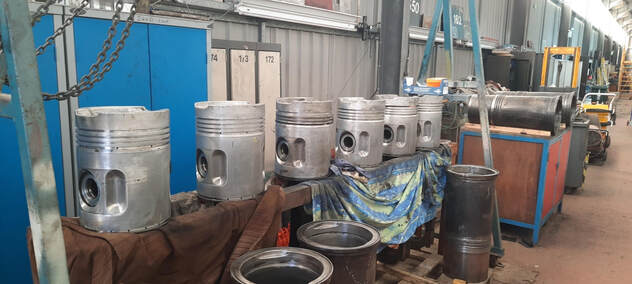
Update on repairs to D5343 (October 2020)
1,) The heads show significant corrosion in the exhaust ports and then significant water damage in the form of pitting around 2 of the exhaust seats....what has happened is the heads (and turbo) have filled with water, which has sat in the heads (where the valves were closed) and gone to work on them (severe pitting).
2,) The heads that had valves open allowed water into the bores, this has pooled around the piston rings and then rusted the iron rings to the iron liner, in the case of liners 6 and 5 this caused severe staining inside the liners and a few noticeable marks where the rings sat, in the case of liners 3 and 2 this caused severe pitting.
What we don't know is whether the pitting occurred as a result of the water....or as a result of running the engine with the defects present, if it is the latter then we know that in 4 to 5 years the pitting will be a lot bigger, which will manifest as running problems with engine and eventually catastrophic failure.
As we know the engine was running ok and the loco was capable of tackling some of the most demanding preserved lines, but we also know the engine was hiding some severe defects.
We could put the liners back in and get another good few year running out of the loco, however we would be putting components back in that ordinarily would be rejected.
The options are as follows.
1,) If liners are not available - reuse the damaged liners
2,) If liners are available but £1000+ each - reuse the damaged liners
3,) if liners are available at a cheaper price, strongly consider replacement
The older liners have an existing issue of damage in the form of corrosion to the seal lands, this would mean ordinarily an instant rejection from BR, we can repair but we are very reliant on chemical metal to do this, coupled with the fact that they have an existing defect (internal corrosion) meaning that each liner has an internal and an external fault.
The overall recommendation is to purchase 4 new liners at a cost of around £750 each plus VAT to replace the defective ones.
Elsewhere the engine overhaul is progressing. The heads are having the valve seats lapped, as described earlier some were in very poor condition. One exhaust valve was found to be damaged beyond repair, and will be discarded, and replaced with a spare. The fuel pumps and injectors have been fully overhauled and it has been found that the loco has been running with an incorrect fuel pump...which would explain the unique engine note the loco has when it gets hot. this has now been replaced with a pump of the correct type. When cold however it would have contributed greatly to the dilution of the oil with fuel.
Pistons have all been cleaned and inspected, groove wise they are all in specification, however 2 of the pistons have 7.5mm grooves with one of them worn beyond 7.5mm. The maximum groove size is 7.5mm with a maximum vertical play of .5mm on the ring. This means that when the groove wears beyond 8mm the piston is scrap, the larger the vertical play beyond the .5mm increment, the faster the groove wears. This means that this will likely be the last overhaul some of the pistons can withstand. It sounds dramatic but it's a position that a lot of locomotives a lot younger than D5343 are in. It is also likely that other major components (tyres, main generator) will fail long before the engine comes up for major attention before we have to look at the engine again.
Internally in the block significant corrosion has been found in the seal surface (where the liner seals go) which wasn't unexpected having seen the corrosion in the liner seal lands, but it's a difficult one to repair. We need to use chemical metal on this, otherwise even the new liners will leak when we put them back in. This damage would see the block written off if this was discovered at overhaul time.
This winter the loco will hopefully go in the shed and the final roof panel will come off, externally the roof is in good condition but we already know that (as with the other panels) the seal is life expired, and water is able to get into the engine room and more concerningly into the electrical cubicle, and for such a cheap repair its invaluable.
Other areas of work are the traction motor bellows which are in pretty poor condition, these have been removed for attention and quotes being obtained for replacements. The last resort is to cut the damaged material away, and re-attach the bellows, but this shortens the bellow and causes more stress, but it gets a few more years out of them.
1,) The heads show significant corrosion in the exhaust ports and then significant water damage in the form of pitting around 2 of the exhaust seats....what has happened is the heads (and turbo) have filled with water, which has sat in the heads (where the valves were closed) and gone to work on them (severe pitting).
2,) The heads that had valves open allowed water into the bores, this has pooled around the piston rings and then rusted the iron rings to the iron liner, in the case of liners 6 and 5 this caused severe staining inside the liners and a few noticeable marks where the rings sat, in the case of liners 3 and 2 this caused severe pitting.
What we don't know is whether the pitting occurred as a result of the water....or as a result of running the engine with the defects present, if it is the latter then we know that in 4 to 5 years the pitting will be a lot bigger, which will manifest as running problems with engine and eventually catastrophic failure.
As we know the engine was running ok and the loco was capable of tackling some of the most demanding preserved lines, but we also know the engine was hiding some severe defects.
We could put the liners back in and get another good few year running out of the loco, however we would be putting components back in that ordinarily would be rejected.
The options are as follows.
1,) If liners are not available - reuse the damaged liners
2,) If liners are available but £1000+ each - reuse the damaged liners
3,) if liners are available at a cheaper price, strongly consider replacement
The older liners have an existing issue of damage in the form of corrosion to the seal lands, this would mean ordinarily an instant rejection from BR, we can repair but we are very reliant on chemical metal to do this, coupled with the fact that they have an existing defect (internal corrosion) meaning that each liner has an internal and an external fault.
The overall recommendation is to purchase 4 new liners at a cost of around £750 each plus VAT to replace the defective ones.
Elsewhere the engine overhaul is progressing. The heads are having the valve seats lapped, as described earlier some were in very poor condition. One exhaust valve was found to be damaged beyond repair, and will be discarded, and replaced with a spare. The fuel pumps and injectors have been fully overhauled and it has been found that the loco has been running with an incorrect fuel pump...which would explain the unique engine note the loco has when it gets hot. this has now been replaced with a pump of the correct type. When cold however it would have contributed greatly to the dilution of the oil with fuel.
Pistons have all been cleaned and inspected, groove wise they are all in specification, however 2 of the pistons have 7.5mm grooves with one of them worn beyond 7.5mm. The maximum groove size is 7.5mm with a maximum vertical play of .5mm on the ring. This means that when the groove wears beyond 8mm the piston is scrap, the larger the vertical play beyond the .5mm increment, the faster the groove wears. This means that this will likely be the last overhaul some of the pistons can withstand. It sounds dramatic but it's a position that a lot of locomotives a lot younger than D5343 are in. It is also likely that other major components (tyres, main generator) will fail long before the engine comes up for major attention before we have to look at the engine again.
Internally in the block significant corrosion has been found in the seal surface (where the liner seals go) which wasn't unexpected having seen the corrosion in the liner seal lands, but it's a difficult one to repair. We need to use chemical metal on this, otherwise even the new liners will leak when we put them back in. This damage would see the block written off if this was discovered at overhaul time.
This winter the loco will hopefully go in the shed and the final roof panel will come off, externally the roof is in good condition but we already know that (as with the other panels) the seal is life expired, and water is able to get into the engine room and more concerningly into the electrical cubicle, and for such a cheap repair its invaluable.
Other areas of work are the traction motor bellows which are in pretty poor condition, these have been removed for attention and quotes being obtained for replacements. The last resort is to cut the damaged material away, and re-attach the bellows, but this shortens the bellow and causes more stress, but it gets a few more years out of them.
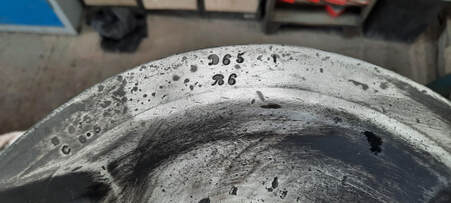
Previous Updates
Since work on the loco restarted in July, the cylinder liners have been inspected thoroughly. Internally they are all in spec, although externally one is a candidate for rejection due to a large score and major external corrosion. A few of them have some corrosion as well but can be brought back into serviceable condition.
The pistons have also been examined and are not quite as they could be, some of the ring grooves have wear and it is likely that some of the rings will need to be replaced.
You will see from the picture that No.4 piston is originally from a Class 45 - marked as D65, later 45111 'Grenadier Guardsman'!
Work is also carrying on in the background to clean all the parts that need cleaning. All the piston rings have been removed so they can be checked for wear. The next stage will be to internally clean the liners, and then check the condition of the cylinder heads. The fuel pumps are being sent away for re-calibration.
Since work on the loco restarted in July, the cylinder liners have been inspected thoroughly. Internally they are all in spec, although externally one is a candidate for rejection due to a large score and major external corrosion. A few of them have some corrosion as well but can be brought back into serviceable condition.
The pistons have also been examined and are not quite as they could be, some of the ring grooves have wear and it is likely that some of the rings will need to be replaced.
You will see from the picture that No.4 piston is originally from a Class 45 - marked as D65, later 45111 'Grenadier Guardsman'!
Work is also carrying on in the background to clean all the parts that need cleaning. All the piston rings have been removed so they can be checked for wear. The next stage will be to internally clean the liners, and then check the condition of the cylinder heads. The fuel pumps are being sent away for re-calibration.
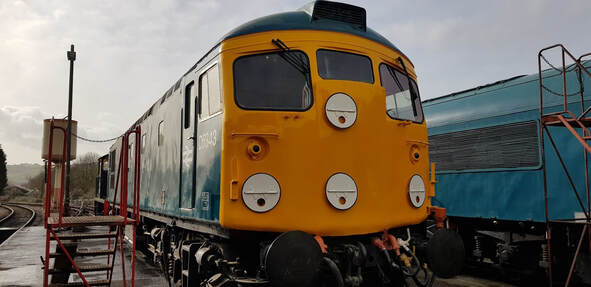
Previous Updates
By the end of March 2020, the engine strip down of D5343 to attend to defective cylinder liners was complete.
The photo (left) shows the loco outside the shed at Toddington on 23/02/20.
Bearing wise the engine is in excellent condition, the bearings on all 6 big ends have minor scoring but very little in terms of actual wear. The engine runs on standard bearings so if this was a repair item it would be in the region of £1500 but thankfully this isn't required.
Pistons are in good condition for their age, with minor slap present and a little damage present on the skirts, but nothing too bad. One piston ring was broken, which looks like it has been broken since BR installed it in the bore. Thankfully it was intact, but there is signs of wear on the bore where the ring has been trapped.
Cylinder liners internally are not brilliant, with some damage mainly due to where the locomotive sat out of use for a number of years and water/condensation has formed around the piston rings, causing them to eat into the liner walls. We had a similar issue on 45149 which caused us to reject the fitted liners, which at the time was a simple process, since the liners were readily available from Booth's scrapyard. That is no longer the case so we will have to live with what we have...
Externally is not very good news, with No.1 liner showing significant corrosion around the bore external to where the cylinder liner seals sit, which is not unusual and is normally the reason why liners get rejected. This is caused where the seal fails and water sits behind the seal this causing corrosion and pitting. Without intervention it is unlikely the liner will seal successfully with water, let alone antifreeze, so we will have to use chemical metal to re-fill the pitting, which is the cheapest option.
Top deck wise, everything is in order, it is likely new transition cups will be needed but we will see how they clean up. The fuel pumps are likely to be sent away for re-calibration/overhaul since on strip down it was noted that there is a continual fuelling issue.
The extensive work to the metal on both front ends of D5343 has been successfully completed and yellow top coat applied. The discs have also been cleaned, repainted and refitted with them being treated to black painted edges, an embellishment that was very Scottish Region.
By the end of March 2020, the engine strip down of D5343 to attend to defective cylinder liners was complete.
The photo (left) shows the loco outside the shed at Toddington on 23/02/20.
Bearing wise the engine is in excellent condition, the bearings on all 6 big ends have minor scoring but very little in terms of actual wear. The engine runs on standard bearings so if this was a repair item it would be in the region of £1500 but thankfully this isn't required.
Pistons are in good condition for their age, with minor slap present and a little damage present on the skirts, but nothing too bad. One piston ring was broken, which looks like it has been broken since BR installed it in the bore. Thankfully it was intact, but there is signs of wear on the bore where the ring has been trapped.
Cylinder liners internally are not brilliant, with some damage mainly due to where the locomotive sat out of use for a number of years and water/condensation has formed around the piston rings, causing them to eat into the liner walls. We had a similar issue on 45149 which caused us to reject the fitted liners, which at the time was a simple process, since the liners were readily available from Booth's scrapyard. That is no longer the case so we will have to live with what we have...
Externally is not very good news, with No.1 liner showing significant corrosion around the bore external to where the cylinder liner seals sit, which is not unusual and is normally the reason why liners get rejected. This is caused where the seal fails and water sits behind the seal this causing corrosion and pitting. Without intervention it is unlikely the liner will seal successfully with water, let alone antifreeze, so we will have to use chemical metal to re-fill the pitting, which is the cheapest option.
Top deck wise, everything is in order, it is likely new transition cups will be needed but we will see how they clean up. The fuel pumps are likely to be sent away for re-calibration/overhaul since on strip down it was noted that there is a continual fuelling issue.
The extensive work to the metal on both front ends of D5343 has been successfully completed and yellow top coat applied. The discs have also been cleaned, repainted and refitted with them being treated to black painted edges, an embellishment that was very Scottish Region.
The pictures above show the work taking place on D5343 during November 2019, with the yellow end rubbed down to expose the corrosion areas and then new metal welded in. Photos by Simon Townsend.
The pictures below show further work taking place on the roof and around the top of the cabs. The roof was fully shotblasted with no corrosion found, the body structures were in good condition with just some surface rust evident. Apart from a little corrosion around the window frames, the general metalwork on the cabs was in excellent condition.
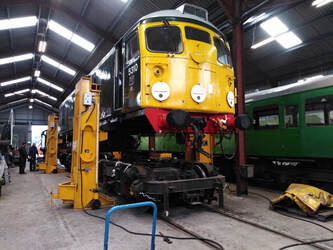
In 2019, D5343 was joined at Toddington by classmate D5310 (26010) from the Llangollen Railway (pictured up on jacks at Toddington). The plan was for two traction motors to be overhauled, one to go in D5310 and one in D5343. However, on closer inspection it became apparent that all of D5310s motors required overhaul, so the loco had an extended stay at the GWR, finally returning to Llangollen in August 2020.
In 2019, D5343 was joined at Toddington by classmate D5310 (26010) from the Llangollen Railway (pictured up on jacks at Toddington). The plan was for two traction motors to be overhauled, one to go in D5310 and one in D5343. However, on closer inspection it became apparent that all of D5310s motors required overhaul, so the loco had an extended stay at the GWR, finally returning to Llangollen in August 2020.
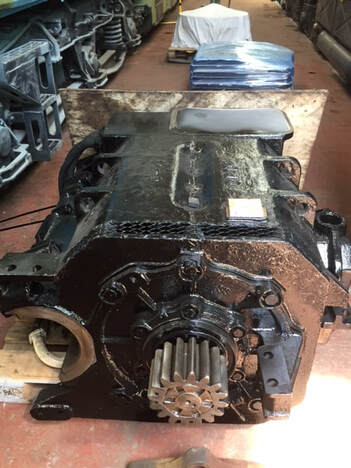
The picture on the left shows one of D5343s original Crompton Parkinson traction motors, overhauled and in the diesel shed at Toddington, ready for fitting into D5310.
